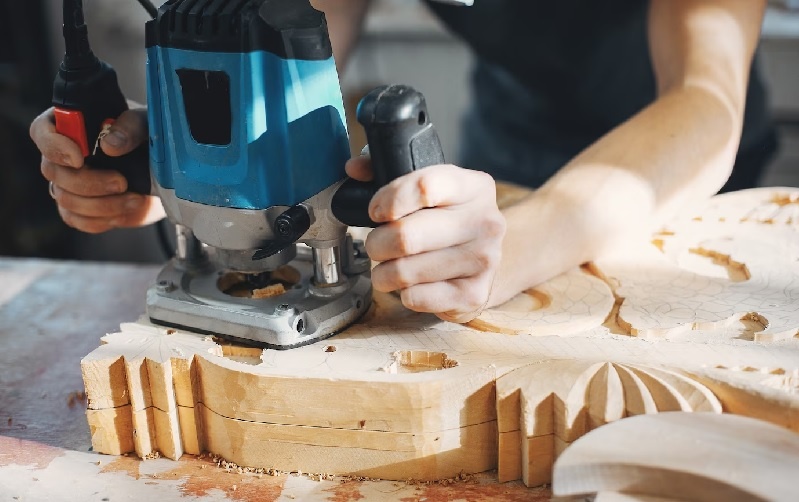Production revamp wanted in woodwork
 |
| Production revamp wanted in woodwork, Source: freepik.com |
Su Quan Wo, chairman of the Lun Jiao Woodworking Machinery Association in Guangdong, China, paid a visit to the southern province of Binh Duong last month to explore partnership opportunities.
He told VIR, “Vietnam has the potential, while China has the technology. Businesses of the two countries can cooperate to stimulate the development of Vietnam’s wood processing industry, as the US is trying to lessen its dependence on Chinese goods.”
According to Wo, China has supplied most of the woodworking machines for the Vietnamese market for many years, ranging from popular to modern and automated types, meeting cost and efficiency requirements. There is currently no Chinese manufacturer on the same scale as Germany’s Weinig and Homag or Italy’s SCM and Biesse.
Moreover, Chinese machines are about 20-30 per cent cheaper than their European competitors. The performance and stability of machines are almost the same, while usage and maintenance costs are lower.
“Vietnam is similar to China in the 1990s. The market is flooded with outdated woodworking machines,” Wo said. “The woodworking machinery industry only truly develops when the Chinese government outlines a clear strategy to support industry development, especially in each locality.”
In particular, Foshan is home to most of China’s largest woodworking machine manufacturers, while Shandong specialises in manufacturing machines that use industrial wood. Zhejiang and Sichuan also produce woodworking machines.
In previous years, Wo’s presentation might have attracted the attention of Vietnamese wood processing companies. However, they are not very excited given that Vietnam’s furniture exports are slowing.
In the first eight months of 2023, Vietnam’s wood and timber product industry reached an export value of $7.78 billion. There is not long left to achieve the target of $17 billion set for the year.
According to Nguyen Phuong, general director of Minh Thanh Company in the southern province of Dong Nai, the company has made a comprehensive investment in modern wood processing machines to comply with the quality requirements of the export markets, and the company adopts European technology.
This is a testament to Minh Thanh’s efforts in investing in machinery and equipment. On the other hand, it touches on the most worrying problem facing wooden furniture manufacturers today: investing in technology to increase productivity, product quality, and profits.
“China’s wood industry is expanding its operation to countries in the region, such as Vietnam, Malaysia, and Thailand, which have good human resources,” said David Chen, general director of ZongFu Ying in Foshan. “We hope to share our machinery manufacturing experience with Vietnamese partners. This helps promote the production capacity of both sides.”
“Over the past five years, Vietnam’s wood industry has overtaken Malaysia in its automation level. The localisation rate of woodworking machines is also increasing in Vietnam, but it is just the beginning. Vietnamese manufacturers still have to go through processes of learning, testing, and improving products.”
Thanks to the positive growth momentum over many years, Vietnam has become the world’s second-largest wood processing and export centre, after China.
However, Le Duc Hieu, director of wood processing machinery group Vetta Company, said, “While many Vietnamese wood furniture manufacturers with the financial capability have accumulated money to invest in modern machines as well as software for smart manufacturing, only about 10 per cent of businesses actually make investments to change production methods.”
According to Hieu, some companies make separate investments by replacing priority parts of machinery. These investments bring relatively good results and improve productivity to some extent.
“However, Vietnam’s wood processing industry is still inferior to its regional peers. The industry remains fragmented in terms of creating a smart and efficient production process. However, there are very few domestic businesses investing in this closed-loop production process,” Hieu said.
| Nguyen Quoc Tri - Deputy Minister of Agriculture and Rural Development
Vietnam’s forestry sector has achieved all five targets assigned by the government, including afforestation, forest protection, exploitation of forest products, forest environmental services, and export value. As a result, Vietnam has become the world’s sixth-largest exporter of wood and wooden products, with more than 4 per cent of the global market, the second-largest in Asia, and the biggest in Southeast Asia. Vietnamese wood products are present in more than 163 countries. However, its wood processing industry still faces difficulties in terms of regaining growth momentum from now until the year-end. The exports of wood and timber products depend on the economic growth of many countries, especially the US market, which makes up over half of the total export turnover of Vietnam’s wood industry. To achieve this year’s target of $17 billion, the Ministry of Agriculture and Rural Development must coordinate with wood associations to implement support programmes for businesses, like organising trade and brand promotion, planning large timber plantations and high-tech forestry zones, and promoting green transformation in the wood processing industry. Vu Ba Phu - Director Vietnam Trade Promotion Agency
There are still many uncertainties stemming from supply constraints, inflationary pressures, shrinking purchasing power, high energy costs, and logistics issues. The main export markets, such as the US and EU, continue to reduce import demand due to the consequences of inflation, economic recession, and low consumer confidence. For European markets, although businesses are interested in new-generation free trade agreements, they still face requirements about technical standards, conformity, and rules of origin. Moreover, the passing of a new EU law banning products linked to deforestation will be a big challenge for Vietnam’s wood and timber exports to this market. Abundant supply and high inventory in markets, especially Japan and South Korea, led to orders slowing down and export prices of wood falling. The Chinese market has reopened, but the domestic supply chain has not completely recovered, which brings many risks. The Ministry of Industry and Trade is coordinating with ministries, sectors, and localities to implement many trade promotion activities to increase the market penetration of wood and timber products. To Xuan Phuc - Director, Forest Trends
There is a wide gap between foreign-invested and domestic enterprises in the factors driving declining export turnover. Similar to other export-oriented industries, the export markets for Vietnam’s wood and timber products are shrinking. According to the Ministry of Agriculture and Rural Development, the export turnover of the industry decreased by 27.5 per cent over the same period last year. However, the momentum for decreasing export turnover is foreign-invested enterprises (FIEs) and domestic manufacturers. The difference is reflected in aspects such as the participation of FIEs and domestic enterprises in the production and export of each specific product group, the characteristics of export products, and the output markets. First are the low value-added products, including wood chips and pellets. Each year, the export turnover of Vietnam’s wood chips accounts for 15-16 per cent of the total exports of the entire wood industry. This ratio is about 4-5 per cent for wood pellets. There is almost no difference in the decline momentum between FIEs and domestic companies. In H1/2023, the export turnover of Vietnam’s wood chips decreased by 15.3 per cent over the same period in 2022. Second are the medium value-added products, typically plywood. On average, the export turnover of Vietnam’s plywoods makes up 6-7 per cent of the export turnover of the industry. The supply chain of plywood production and export is dominated by domestic companies. However, there is an increasing participation of FIEs in the production and export of this type of product. In 2022, 56 of these firms engaged in exports of plywood, compared with just over 360 domestic counterparts. The export turnover of FIEs accounted for almost one-quarter of the industry, while the export turnover of domestic manufacturers represented just over three-quarters. In the first half of 2023, plywood saw a 31 per cent increase in export turnover compared with last year’s period. The export turnover of FIEs decreased more significantly than that of domestic groups. One reason behind the difference in the decline between the two business groups is that the US Department of Commerce has extended its duties investigation into plywood from Vietnam. As a result, many FIEs decided to postpone or limit the export activities of plywood to the US market. For the high value-added products, FIEs are more active in the export of this product group than the low and medium value ones. For example, chairs are a high value-added item, with export turnover accounting for around 20 per cent of the export turnover of the entire industry. Many FIEs specialise in the production of this product. In 2022, there were around 330 FIEs exporting chairs, compared to just over 1,000 domestic producers. FIEs generated $1.95 billion in the export turnover of chairs, responsible for 65.3 per cent of the total export turnover of this item in Vietnam. Meanwhile, domestic enterprises posted $1 billion for the export turnover of chairs, accounting for 34.7 per cent. The difference between the two groups is also reflected in terms of the markets. Wood products exported to international markets such as the US and EU often have high value-added content, such as chairs and furniture. Many FIEs participate in exporting these high-value products to these markets. |
What the stars mean:
★ Poor ★ ★ Promising ★★★ Good ★★★★ Very good ★★★★★ Exceptional
Related Contents
Latest News
More News
- Businesses ramp up production as year-end orders surge (December 30, 2025 | 10:05)
- Vietjet chairwoman awarded Labour Hero title (December 29, 2025 | 13:06)
- How to unlock ESG value through green innovation (December 29, 2025 | 10:03)
- AI reshapes media and advertising industry (December 29, 2025 | 08:33)
- FPT and GELEX sign deal to develop blockchain tech for global markets (December 29, 2025 | 08:29)
- Vietnam’s GDP forecast to grow by 9 per cent in 2026 (December 29, 2025 | 08:29)
- Women entrepreneurs are key to Vietnam’s economic growth (December 29, 2025 | 08:00)
- Vietnam's top 500 value-creating enterprises announced (December 27, 2025 | 08:00)
- The PAN Group shaping a better future with ESG strategy (December 26, 2025 | 09:00)
- Masan Consumer officially lists on HSX, marking the next phase of value creation (December 25, 2025 | 13:20)




 Tag:
Tag:




















 Mobile Version
Mobile Version